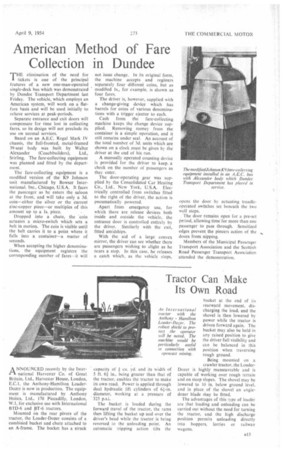American Method of Fare Collection in Dundee T HE elimination of
Page 49

If you've noticed an error in this article please click here to report it so we can fix it.
the need for tickets is one of the principal features of a new one-man-operated single-deck bus which was demonstrated by Dundee Transport Department last Friday. The vehicle, which employs an American system, will work on a flatfare basis and will be used initially to relieve services at peak-periods.
Separate entrance and exit doors will compensate for time lost in collecting fares, so its design will not preclude its use on normal services.
Based on an A.E.C. Regal Mark IV chassis, the full-fronted, metal-framed 39-seat body was built by Walter Alexander (Coachbuilders), Ltd., Stirling. The fare-collecting equipment was planned and fitted by the department.
The fare-collecting equipment is a modified version of the K9 Johnson unit manufactured by Bowser International, Inc., Chicago, U.S.A. It faces the passenger as he enters the saloon at the front, and will take only a 3d. coin—either the silver or the current zinc-copper piece—or multiples of this amount up to a Is. piece. • Dropped into a chute, the 'coin actuates a micro-switch which sets a belt in motion, The coin is visible until the belt carries it to a point where it falls into a container—a matter of seconds.
When accepting the higher denominations, the equipment registers the corresponding number of fares—it will not issue change. In its original form, the machine accepts and registers separately four different coins, but as modified Is., for example, is shown as four fares.
The driver is, however, supplied with a change-giving device which has barrels for coins of various denominations with a trigger ejector to each.
Cash from the fare-collecting machine keeps the change device supplied. Removing money from the container is a simple operation, and it still remains under seal. An account of the total number of 3d. units which are shown on a clock must be given by the driver at the end of his run.
A manually operated counting device is provided for the driver to keep a check on the number of passengers as they eater.
The door-operating gear was supplied by the Consolidated Car Heating Co., Ltd., New York, U.S.A. Electrically controlled from switches fitted to the right of the driver, the action is pneumatically powered.
Apart from emergency use, for which there are release devices both inside and outside the vehicle, the entrance door is controlled entirely by the driver. Similarly with the exit, fitted amidships.
With the aid of a large convex mirror, the driver can see whether there are passengers wishing to alight as he nears a stop. In this case, he releases a catch which, as the vehicle slops. opens the door by actuating treadleoperated switches set beneath the two well steps.
, The door remains open for a pre-sct period, allowing time for more than one passenger to pass through. Sensitized edges prevent the pincers action of the doors from nipping.
Members of the Municipal Passenger Transport Association and the Scottish Road Passenger Transport Association attended the demonstration.




































































































